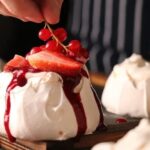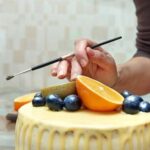Are you looking to add a touch of natural beauty to your next cake creation? In this article, we will explore how to decorate a cake with edible flowers. Edible flowers can elevate the appearance of any cake, providing a stunning and unique finishing touch. From selecting the perfect flowers to safety considerations, we will cover everything you need to know to create a gorgeous floral masterpiece.
Edible flowers have been used for centuries in culinary arts, adding color, flavor, and visual appeal to various dishes. When it comes to cake decorating, edible flowers offer an elegant and organic way to enhance the overall look of your creation. Whether you’re planning for a special occasion or simply want to impress your friends and family at a gathering, incorporating edible flowers into your cake design can truly take it to the next level.
In this article, we will not only introduce you to the world of edible flowers but also provide you with practical tips on selecting the right blooms for your cake, preparing them for decoration, and various techniques for arranging and showcasing them on your sweet masterpiece. Let’s dive into the wonderful world of edible flowers and discover how they can transform your cakes into stunning works of art.
Types of Edible Flowers for Cake Decorating
When it comes to decorating a cake with edible flowers, it’s important to choose the right types of flowers to ensure both visual appeal and safety. There are several types of edible flowers that are popular choices for cake decoration. Here are some of the most commonly used edible flowers for cake decorating:
- Roses: Roses are not only beautiful but also edible, making them a popular choice for decorating cakes. Choose unsprayed roses specifically grown for consumption.
- Marigolds: These vibrant orange and yellow flowers are often used to add a pop of color to cakes and other desserts. They have a slightly citrusy flavor that can complement the sweetness of the cake.
- Violets: Violets come in various shades of purple and white, making them a versatile choice for decorating cakes. They have a slightly sweet flavor that pairs well with many different cake flavors.
- Lavender: With its delicate fragrance and light purple hue, lavender is a popular choice for adding a subtle floral flavor and aroma to cakes.
In addition to these popular choices, there are many other edible flowers such as pansies, chamomile, and calendula, all of which can be used to decorate cakes in unique and creative ways.
When selecting edible flowers for cake decorating, it’s important to ensure that they are grown organically and free from any pesticides or other harmful chemicals. It’s also essential to verify that the flowers are indeed safe for consumption and have not been treated with any non-edible substances.
Selecting the Perfect Flowers for Your Cake
When selecting edible flowers for your cake, it’s essential to ensure that they are not only safe to eat but also free from pesticides or other harmful chemicals. It is recommended to use organic or homegrown flowers that have not been treated with any harmful substances. Additionally, it’s important to verify that the selected flowers are indeed edible and not toxic.
One key consideration when selecting the perfect flowers for your cake is whether you want fresh or dried blooms. Fresh flowers are a popular choice for cake decoration as they provide vibrant colors and natural beauty. Dried blooms can also be used and offer a longer shelf life, making them ideal for long-lasting decorations.
| Popular Edible Flowers | Considerations |
|---|---|
| Roses | Check if pesticide-free and non-toxic |
| Pansies | Choose organic or homegrown options |
| Lavender | Consider using dried blooms for longer shelf life |
Preparing Edible Flowers for Cake Decoration
When using edible flowers to decorate a cake, it is essential to properly prepare them to ensure they are safe for consumption and look their best on your masterpiece. Before using any flowers on your cake, it is important to thoroughly clean them to remove any dirt, insects, or other impurities. This can be done by gently rinsing the flowers in cold water and then allowing them to air dry on paper towels.
Once the flowers are clean and dry, it is important to remove any non-edible parts such as stems, pistils, and stamens. These parts can have a bitter taste and may not be visually appealing on the cake. Carefully pluck the petals from larger flowers such as roses or peonies, leaving only the soft and colorful petals for decorating.
After preparing the flowers, it is crucial to store them properly until you are ready to use them on your cake. Keep the prepared edible flowers in a cool and dark place, preferably in an airtight container with a slightly damp paper towel to help maintain their freshness. By taking these steps to prepare your edible flowers for cake decoration, you can ensure that they not only look beautiful but also remain safe for consumption on your culinary creation.
Decorating Techniques for Edible Flowers
When it comes to decorating a cake with edible flowers, there are a few different techniques you can use to create a beautiful and eye-catching design. Here are some popular decorating techniques to consider:
1. Whole Flower Arrangement: One of the simplest ways to decorate a cake with edible flowers is to simply place whole flowers on top of the frosting. This technique works best with small, delicate flowers such as violets or pansies. You can arrange the flowers in a random pattern or create a more structured design.
2. Petal Placement: Another popular technique is to remove the petals from larger edible flowers, such as roses or peonies, and arrange them in a pattern on the cake. This allows you to create intricate designs and patterns using the flower petals.
3. Flower Crown: For a more whimsical look, consider creating a “flower crown” around the edge of the cake. Use small, dainty flowers like baby’s breath or chamomile to create a delicate border around the top of the cake.
These decorating techniques can be used individually or in combination to create a truly stunning cake that will impress your guests and make any occasion even more special. Experiment with different types of edible flowers and arrangements to find the perfect look for your cake.
Remember that not all flowers are safe for consumption, so be sure to do your research before using any type of flower on your cakes. With these decorating techniques, you can elevate any ordinary dessert into an extraordinary masterpiece that is as delicious as it is beautiful.
Tips for Arranging Edible Flowers on a Cake
Arranging edible flowers on a cake can be a beautiful and creative way to add a pop of color and natural elegance to your dessert. Whether you are decorating a birthday cake, wedding cake, or any other special occasion cake, there are some important tips to keep in mind when arranging edible flowers.
Consider the Size and Shape of the Flowers
When arranging edible flowers on a cake, it’s essential to consider the size and shape of the flowers. Larger blooms can be used as a focal point or as statement pieces on the cake, while smaller flowers can be used to fill in gaps and add delicate touches. Additionally, consider the overall shape of the flowers-some may work better as accents around the edges of the cake, while others can be placed more prominently in the center.
Layering and Clustering
To create visual interest and depth when arranging edible flowers on a cake, consider layering and clustering them together. You can achieve this by gently placing different blooms on top of each other or by grouping similar flowers in clusters around the cake. This technique adds dimension to the decoration and creates a cohesive look.
Mindful Placement
When arranging edible flowers on a cake, be mindful of their placement. Avoid placing them directly where someone will cut into the cake to ensure that no one accidentally consumes any non-edible parts such as stems or leaves. Additionally, make sure that the placement is aesthetically pleasing-consider how each flower interacts with the others and with any other decorative elements on the cake.
By keeping these tips in mind, you can create a stunning floral display on your cake that is not only visually appealing but also safe for consumption. With careful consideration of flower size, layering techniques, and mindful placement, you can achieve an artful arrangement that elevates your cake decoration to new heights.
Safety Considerations When Using Edible Flowers
When it comes to using edible flowers for cake decorating, safety should be a top priority. Not all flowers are safe for consumption, and some may even be toxic if ingested. It is crucial to know which flowers are edible and how to properly prepare them for use on cakes.
First and foremost, it is important to source your edible flowers from reputable suppliers or ensure that they have been grown without the use of pesticides or other harmful chemicals. If you are foraging for edible flowers, make sure you have positively identified each flower before using it for decoration. Additionally, if you have any doubts about the safety of a particular flower, it is best to err on the side of caution and avoid using it.
Before applying edible flowers to your cake, wash them thoroughly and remove any pollen or insects that may be present. It is also advisable to cut off the bitter white base of certain flowers such as pansies and nasturtiums before using them in cake decorating. This will ensure that only the most flavorful and safe parts of the flowers are used in the decoration process.
Furthermore, when placing edible flowers on a cake, consider whether any non-edible elements such as stems or leaves will come into contact with the cake itself. These should be carefully removed to prevent any unwanted flavors or textures from affecting the final product.
| Safety Considerations | Edible Flower Safety Tips |
|---|---|
| Source from reputable suppliers | Ensure that flowers have been grown without pesticides |
| Proper identification | Avoid using unknown or potentially unsafe flowers |
| Thorough washing | Remove pollen, insects, and bitter parts before use |
| Check for non-edible elements | Remove stems and leaves that may affect the cake’s flavor |
Examples of Gorgeous Cakes Decorated With Edible Flowers
Springtime Delight
One example of a gorgeous cake decorated with edible flowers is a springtime delight. This type of cake is usually adorned with pastel-colored edible flowers such as pansies, violets, and lilacs. The flowers are strategically placed to create a whimsical and garden-fresh look, perfect for spring or Easter celebrations. The delicate and vibrant colors of the edible flowers add a touch of elegance to the cake, making it a stunning centerpiece for any special occasion.
Boho Chic Wedding Cake
For weddings or bohemian-themed events, a boho chic wedding cake decorated with edible flowers is a popular choice. These cakes typically feature an assortment of wildflowers such as daisies, lavender, and chamomile. The flowers are arranged in a cascading or scattered pattern to create a romantic and free-spirited look. Edible gold or silver leaf accents may also be added to enhance the overall aesthetic of the cake.
Vintage Garden Party Cake
A vintage garden party cake decorated with edible flowers exudes an old-world charm and timeless elegance. This type of cake often includes classic blooms such as roses, peonies, and carnations. The flowers are arranged in a formal and symmetrical design, reminiscent of English garden parties from decades past. Soft, muted colors like blush pink, ivory, and dusty blue are commonly used to complement the vintage theme and create an air of sophistication.
These examples showcase the versatility of decorating cakes with edible flowers, demonstrating how different floral arrangements can evoke various moods and themes for special occasions.
Conclusion and Final Tips for Decorating a Cake With Edible Flowers
In conclusion, decorating a cake with edible flowers can be a fun and creative way to add a beautiful and unique touch to any special occasion. By following the tips and techniques outlined in this article, you can create stunning cakes that are not only visually appealing but also safe to eat. Remember to always carefully select and prepare your edible flowers, considering both their aesthetics and safety for consumption.
When selecting edible flowers for cake decorating, it’s important to choose organic or pesticide-free options to ensure that the flowers are safe for consumption. Additionally, make sure to properly clean and prepare the flowers before placing them on the cake. When arranging the flowers on the cake, consider color combinations and placement for a visually pleasing result.
Lastly, always consider any potential allergies or sensitivities when using edible flowers on a cake. If you’re unsure about the safety of a particular flower, it’s best to err on the side of caution and avoid using it as decoration. With these final tips in mind, you can confidently adorn your cakes with beautiful and safe edible flowers for all your special events and celebrations.
Frequently Asked Questions
How Do You Get Edible Flowers to Stick to a Cake?
Edible flowers can be easily attached to a cake by using a small amount of frosting or icing as an adhesive. Simply apply a dab of frosting to the back of each flower and gently press it onto the surface of the cake. It’s important to handle the flowers carefully to avoid damaging them during the decorating process.
What Are the Best Edible Flowers for Cake Decorating?
When it comes to choosing the best edible flowers for cake decorating, there are several options to consider. Some popular choices include roses, violets, pansies, lavender, and nasturtiums. It’s important to ensure that any flowers used for decorating are free from pesticides and other chemicals, as these can be harmful if consumed.
How to Decorate a Cake With Icing Flowers?
Decorating a cake with icing flowers can be a fun and creative process. To start, prepare your favorite type of icing and use piping bags fitted with various tips to create different flower shapes and designs.
Start with a base layer of icing on the cake and then add the icing flowers on top, carefully arranging them in a visually appealing way. With practice and patience, you can create beautiful floral designs using icing as a decorative element on your cakes.

Welcome to my blog about home and family. This blog is a place where I will share my thoughts, ideas, and experiences related to these important topics. I am a stay-at-home mom with two young children. I hope you enjoy reading it! and may find some helpful tips and ideas that will make your home and family life even better!





